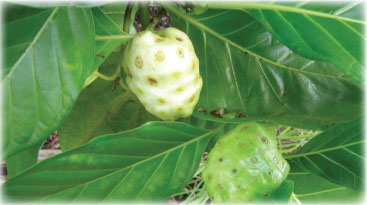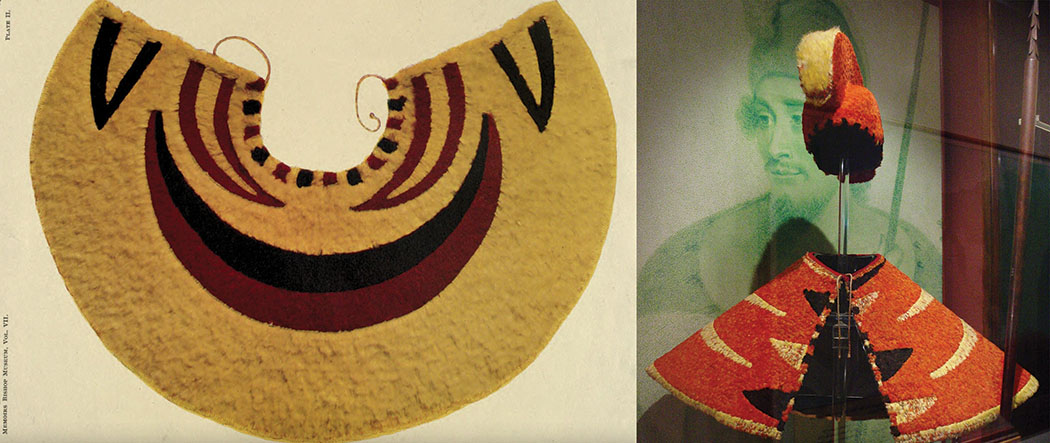
Healthful, Tasty Recipes Using Noni (Yes, really!)
By Barbara Fahs
 Noni is hot. People pay big bucks for a jar of the juice, believed to be a cure for cancer, helpful for chronic respiratory conditions such as tuberculosis, influenza, asthma, coughs, colds, sinusitis and sore throat. It also is believed to be effective for digestive disorders such as diarrhea, constipation, indigestion, gastric ulcers and intestinal parasites. Although it does not appear to have any adverse health effects, it is not recommended for pregnant and nursing women.
Noni is hot. People pay big bucks for a jar of the juice, believed to be a cure for cancer, helpful for chronic respiratory conditions such as tuberculosis, influenza, asthma, coughs, colds, sinusitis and sore throat. It also is believed to be effective for digestive disorders such as diarrhea, constipation, indigestion, gastric ulcers and intestinal parasites. Although it does not appear to have any adverse health effects, it is not recommended for pregnant and nursing women.
Called the Indian mulberry, noni (Morinda citrifolia) is native to Southeast Asia, possibly only to the islands of Indonesia. It occurs from India to Eastern Polynesia and was so valuable to the ancient Polynesian travelers who settled Hawai‘i that it was one of the few plants they selected to carry here on their canoes.
Like the early Polynesians, who used all parts of this small tree, you too can easily grow a noni tree or two on your property, and benefit from its healing powers and attractive appearance. If you live on the windward side of any Hawaiian island, noni does especially well in the moist climate, especially near the ocean. It also thrives in leeward areas, such as Kona. However, it prefers elevations below about 1700 feet.
Noni can grow in areas with virtually no soil and will sometimes pop up in what appears to be solid rock. It’s hard to start from seeds, as you must first soak them — and then you must wait for the long germination period to pass. The best idea is to purchase a young tree. It’s easy to plant a noni tree:
- Dig a hole twice the size of the pot.
- Mix in compost, and then plant your tree to the top of the soil in which it is potted. If the roots are cramped, loosen before you plant.
- Apply mulch around the base to keep weeds away.
- Keep your young tree watered well for the first two months of its life in the ground. After that, the natural rainfall will be sufficient and it will adapt to its environment, whether you live in a wet or dry area.
Fertilizer and pest control are not necessary: Noni is a carefree tree that will start to produce fruit soon after you plant it.
What To Do With All Those Noni
Soon, you will have more noni fruit than you know what to do with. The ripe fruit will drop to the ground when it’s translucent white, and can attract slugs, fruit flies and rats, so pick up the fruit before it makes a big, smelly mess. The best time to pick noni is before it turns white and soft: earmark large, hard yellow fruit and then bring them inside to ripen, away from critters. You’ll know when it’s ready to use because of the smell. Granted, the smell is unpleasant to many people, but if you use it in recipes, the strong odor and taste will be masked by other ingredients. Try one or both of the recipes below to experience a different way of using this healthful fruit.
Noni Vinegar Is the Base for Many Delicious Dishes
Noni makes a wonderful herb vinegar. Apple cider vinegar is the most common and most reasonably priced vinegar: It also has many healing qualities on its own.
When you add noni, the healing effects are more potent. You can use other types of vinegar, depending on the recipe you’re making: Rice vinegar and Balsamic vinegar work nicely with noni. Red wine vinegar is very tasty, especially for Italian dishes. White vinegar is not appropriate.
Be creative! You can combine herbs such as basil and oregano for extra flavor and interest. Garlic and a little Maui onion are also great additions to this versatile vinegar.
- Take one or two very ripe noni, chop them up and fill a quart jar half full with fruit.
- Fill jar with apple cider vinegar and cap tightly.
- Let the jar sit in the sun for several days. If you need your vinegar right away, heat the vinegar in a non-metallic pan such as Pyrex, and then pour it over your noni and other herbs, if included, and let the mixture steep for an hour or longer.
- Strain the mixture and use it in salad dressings and any recipe that calls for vinegar. It’s also great as a gargle for sore throats.
Noni vinegar keeps forever in a cool, dark cupboard — no need to refrigerate. If you keep some in a pretty bottle in your kitchen, you’ll be reminded to use it whenever you need vinegar in a recipe. It’s also a good addition to stir-fry when it needs a little liquid, toward the end of cooking.
Noni-Banana Nut Bread or Muffins
You’ll be surprised how moist and tasty this bread is! And … it doesn’t smell or taste like noni.
- 1/2 cup light salad oil, such as Canola
- 1 cup white sugar
- 2 eggs
- 1/2 cup mashed very ripe Noni (about 2), with seeds removed
- 1/2 cup mashed very ripe bananas
- 2 tsp. vanilla
- 2 cups flour (whole wheat or white)
- 1/2 tsp. salt
- 1 tsp. soda
- 1 tsp. cinnamon
- 1/2 tsp. nutmeg
- 1/2 cup chopped nuts of any kind (walnuts or macadamia)
- 1/2 cup raisins
Blend sugar with oil. Beat in the eggs, noni, banana and vanilla, and then stir until it’s smooth.
Add the flour, soda and salt — no need to sift. Fold in the nuts and raisins and then pour the mixture into muffin tins lined with cupcake papers or a greased 9 by 5-inch bread pan.
For muffins, bake at 325 degrees for about 40 minutes. For bread, bake at 325 for about 60 minutes. Makes one generous loaf of bread or 12 large muffins.


